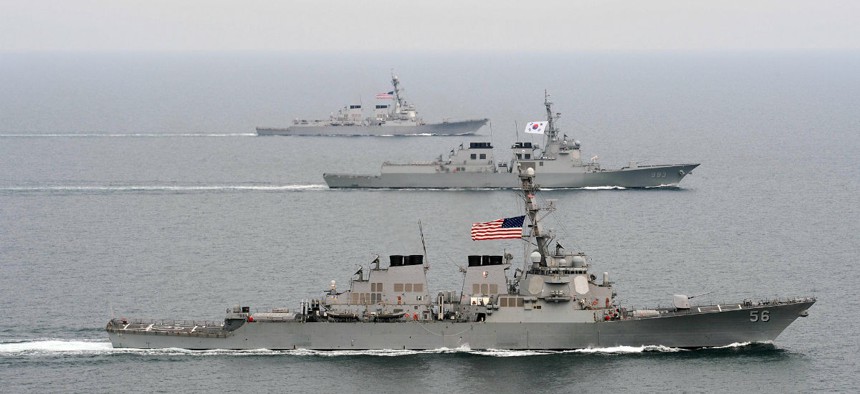
Two U.S. Navy guided missile destroyers flank a Republic of Korea destroyer during an exercise west of the Korean Peninsula. Navy photo by Mass Communication Specialist 3rd Class Declan Barnes
Congress’ Acquisition Priorities for the Navy Don’t Match the Threat
The proliferation of ballistic missiles worldwide is extremely troubling.
As important as it is to effectively counter the pure evil that is ISIS, Daesh, ISIL, the Islamic State or whatever name we give the gang of thugs who murder innocents in the name of religion, it’s equally critical we keep our eye on the greater threat of enemy-launched ballistic missiles to the homeland, our forces around the world and our Allies.
In this season of congressional budgeting, House Appropriations Committee Chairman Hal Rogers said recently, “Protecting our nation from threats to our freedom, democracy, and way of life is the most important responsibility of Congress.”
So why have he and his colleagues charted a course to unilaterally de-fang the U.S. Navy, reducing not only the number of ships in the inventory but also diminishing much needed firepower?
For example, the plan to buy 52 littoral combat ships has been cut to 40. These lightly-armed ships in search of a mission are unlikely to be able to fill the Navy’s offensive requirements outlined in the service’s Distributed Lethality doctrine. Worse, we’re not buying armament for the highly capable guided missile destroyers that are in high demand for both offensive and defensive punch.
Russia and China, as well as Iran and North Korea are threatening the United States and our allies in the Middle East, Europe and Asia with a growing ballistic missile capability. Further, Russian President Vladimir Putin’s forces are on the move in the Crimea, Ukraine, and now their jets are harassing our ships in the Black Sea as Russian Naval forces attempt to relegate those international waters.
China, whose ballistic missile capability is modern and well regarded, is likewise flexing its military muscles by sponsoring a robust shipbuilding program, altering the balance of naval power in the South China Sea. Besides expanding and upgrading their fleet, they are boldly creating new territory from which they could launch attacks, building artificial islands and threatening the right of free passage while also interfering with the economic zones of its neighbors.
This is not good news for Naval planners who will need more, not less offensive and defensive capabilities in the coming years.
Finally, Iran and North Korea, against the will of other nations, have developed, tested, and successfully launched ballistic missiles capable of delivering devastating destruction on allies and possibly on U.S. territories.
If the threat of ISIS is a problem, the proliferation of ballistic missiles worldwide is extremely troubling.
The U.S. plan to counter this emerging Ballistic Missile threat lies with the development and deployment of the SM3 Missile, capable of intercepting and destroying enemy ballistic missiles, and other threats from space. The United States has already invested $2 billion and the Japanese another $1 billion in the SM3 missile thus far.
But the proposed 2017 Congressional markup has cut the already anemic appropriation for 52 missiles to 35. These missiles not only support Aegis Cruisers deployed worldwide, but also “Aegis Ashore” in Romania today and Poland in 2017 to guard against missile launches by rogue Middle Eastern states such as Iran.
With a growing ballistic missile threat, we cannot afford to jeopardize the production line by continuing to buy this capable and critical weapon system in small quantities that limit their deployment and deterrent effect.
We simply cannot afford to fixate on one target at the expense of another. Let’s get the correct balance of Defense spending, fully funding the right mix of Navy ships and weapon systems, and prepare for the threats we face.
Rear Admiral Garry E. Hall retired from the United States Navy after more than 30 years of service and today is a national security and defense strategic advisor at the Spectrum Group in Washington, D.C.






